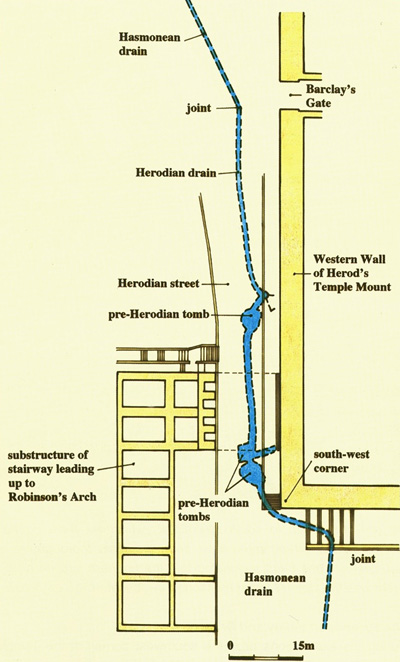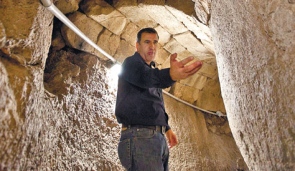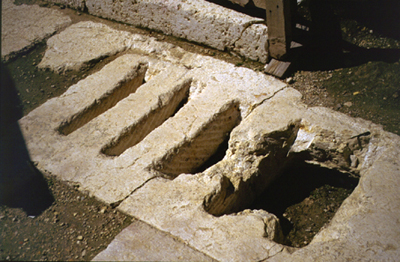On my return from Jordan, I found that it was and still is widely reported that an underground tunnel has been opened in Jerusalem and, as expected, some outrageous Palestinian comments made about the supposed danger to the Temple Mount, such as these:
The tunnel leading from the City of David in Silwan to beneath the walls of Jerusalem’s Old City, excavated by the Israel Antiquities Authority and announced to media fanfare Sunday, is drawing fire from Palestinians who claim it will damage the Temple Mount.
Fatah Revolutionary Council member Dimitri Diliani accused the Jerusalem municipality of Judaizing East Jerusalem and said the digging constituted a “direct danger to al-Aqsa.”
The tunnel in question was first discovered by Charles Warren in the 1870’s, recorded by subsequent excavators such as Bliss and Dickie, Johns and Kathleen Kenyon. A large section below Robinson’s Arch was cleared during Benjamin Mazar’s excavations in the 1970’s. Not only did Warren publish a plan of the tunnel, but in the 1970’s the Irish architect David Sheehan together with my late sister Martha made a detailed survey of the tunnel. The tunnel was constructed as a drain below the street that ran above it.
This plan is based on Warren’s drawing and is published in my book The Quest, p. 56:

There are two distinct phases to be discerned in the tunnel. The older sections to the north and to the south on the plan are roofed with flat slabs, while the central section has a vaulted roof. The flat roofed sections used to belong to one and the same Pre-Herodian, possibly Hasmonean period, while the vaulted section is Herodian.

It is clear from the above plan that the construction of the Herodian southwest corner of the Temple Mount cut the earlier drain and a detour was constructed going round this corner, using short sections of vaulting, to reconnect the drain again. This Herodian section also cut through some First Temple period tombs:

Even Israeli commentators don’t get the purpose of this tunnel right. According to this report:
Visitors are now able to walk from the center of Silwan to the Western Wall plaza within several minutes, via a shaft that researchers believe was used for drawing water from the tunnel. The shaft is in the area of the Davidson Archaeological Park and Center, between the southern wall of the Temple Mount and the Dung Gate, and when the work is completed it will serve as the entrance to the tunnel.
The purpose of this tunnel was not to supply water, but to drain away rainwater that fell on the street and to drain off the sewage of adjacent buildings into the drain:

During the Mazar excavations, this tunnel was visited many times by staff and volunteers alike. It is great to hear that the full length of this drain has been opened all the way down to the Siloam Pool. It will be exciting to walk again through this tunnel, but while doing so, one should also remember that in 70 AD many Jerusalemites tried to escape through this same tunnel, but were cruelly killed by the Romans when they were discovered.

As usual, very nicely written, to the point!
I would like to know more about the “First Temple period tomb”[s].
Thanks
Eliya,
These tombs are part of a First Temple period cemetery to the west of Robinson’s arch. Most of them have a “nefesh” hole in the ceiling. For a brief description, see: “Jerusalem Revealed” (1975), pp. 38-40.
Welcome back Leen,
You mention that this drain has been opened all the way down to the Siloam Pool. Surely, the sewage did not empty into the pool. The pool was filled with water from the Gihon Spring via Hezekiah’s tunnel, being pure enough for ritual bathing, right? Please don’t spoil my image of the blind man there!
Arthur,
The drain does not empty into the Siloam Pool, but by-passes it on the west. You can, however, view it from the present excavation area of the Siloam Pool. The original drain exited at the southern gate of Jerusalem, which was then called the Dung Gate.
This is very helpful for understanding the vaulted vs. slabbed sections of the drain channel, which I had not grasped before (the latter is what is seen in the now-open section in Silwan). So, it seems the Herodian vaulted section is relatively short — a “bypass” around the SW corner of the Temple Mount — and that most of the length of the drain is actually Hasmonean, yes?
TOM POWERS / Jerusalem
See my reply in todays’post.
I am looking for information on The western wall tunnel and for current excuvation done their. Would known where I can look.
Thank you
Wow, I remember scampering down Warrens shaft to crawl along the aqueduct with candle in hand. Now you can stand up?! Cool!. I also remember in 1978 takin g our breaks in the tomb to beat the heat. I also took my Hebrew Univ arch class on a guided tour of the aqueduct in Aug of 1978.